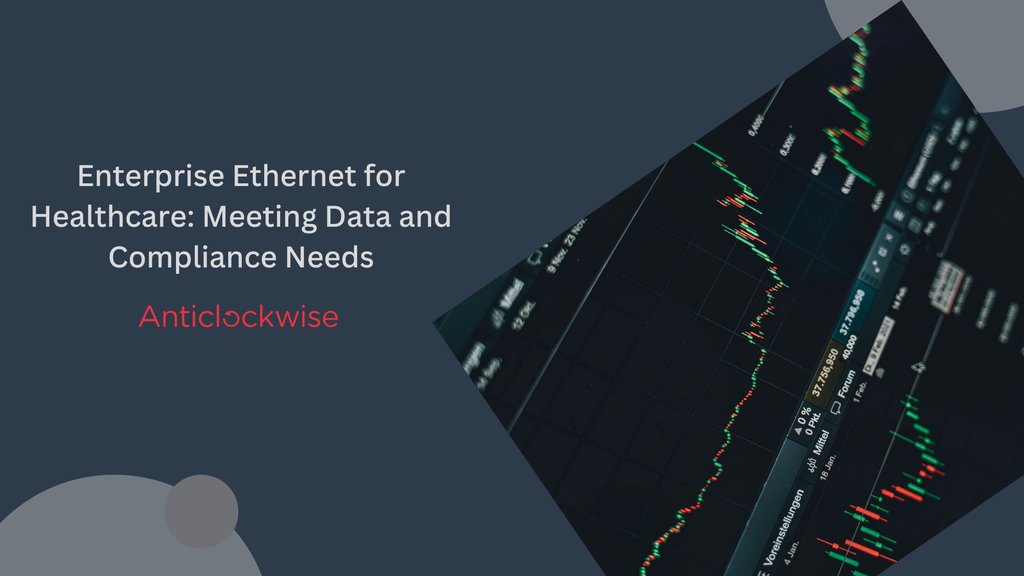
Enterprise Ethernet for Healthcare: Meeting Data and Compliance Needs
The healthcare industry is affected by the digital revolution where there is rapid data generation and consumption. Healthcare firms depend on a fundamentally strong and reliable network infrastructure that incorporates electronic health records (EHRs), medical imaging, telemedicine, and remote patient monitoring. Enterprise Ethernet provides a powerful answer to the peculiar problems of the healthcare industry.
Enterprise Ethernet provides seamless connectivity with high bandwidth and low latency that extends the capabilities of healthcare providers to:
• The speed of data transfer: Rapid transmission of large medical images, complex diagnostic reports, and other essential information.
• Live Collaboration: There are no delays in remote consultations, telemedicine, and distant surgery.
· Better Patient Care: Improve patient outcome through timely information access and prompt decision-making.
· Robust security: Features such as encryption and access controls protect sensitive patient data.
· Compliance: Strict industry laws, such as HIPAA, govern data privacy and security.
This article describes the primary benefits Enterprise Ethernet brings to healthcare, how it addresses industry-specific considerations, and the best practices for installation.
Key Benefits of Enterprise Ethernet for Healthcare
High Bandwidth and Low Latency
Enterprise Ethernet empowers healthcare organisations with its high-bandwidth and low-latency capabilities. Telemedicine consultations, medical imaging, and electronic health records (EHRs) demand significant data transfer speeds. Enterprise Ethernet allows the transfer of high-resolution images at very high speeds and enables rapid diagnosis and treatment. Low latency also remains essential for such real-time applications as remote surgery because this allows seamless communication and coordination among healthcare providers.
Enhanced Network Security
At a time where data breaches are commonplace, it is incumbent on the healthcare sector to take network security seriously. Enterprise Ethernet is scalable and possesses robust security features such as network segmentation, encryption, and tough access control. Such measures keep sensitive patient data safe from access and cyber-aggression. For example, network segmentation allows hospitals to place sensitive information on different parts of the network, thereby limiting exposure after a breach. Encryption, on the other hand, keeps the information transferred across the network private.
- Network segmentation: This involves splitting a network into smaller, compartmented parts that are usually secured against accessing sensitive data. Only authorised devices operating in a certain segment will have a role in accessing the much-needed information.
- Encryption: Data authentication is encrypted before being transmitted and thus remains unreadable by unauthorised parties. This allows for the creation of checks that promise confidentiality for patients' records, even if intercepted.
- Access Controls: User access segmentation prevents unauthorised individuals from accessing sensitive data. These include Multi-Factor Authentication and Role-Based Access Control.
Addressing Healthcare-Specific Challenges with Enterprise Ethernet
Compliance with HIPAA and Other Regulations
To build an Enterprise Ethernet infrastructure requires in-depth modelling of the healthcare networks that operate in a very specific regulatory environment. It contains provisions for HIPAA, the industry standard compliance requirement. Enterprise Ethernet serves the purpose of fulfilling these regulations by helping healthcare firms in providing secure and reliable network connectivity.
Logging information and consistent with plausible security measures would ensure confidentiality, integrity, and availability of patient data.
Supporting Remote Workforces
Telemedicine is one of the representatives that embodies the shift to remote jobs within the healthcare sector. The circle consists of the Enterprise Ethernet wherein medical staff can remotely access patient records while interacting with partners on the care side of the operation. This step helps realize remote consultations for changing access to care among patients, a fast-increasing trend of working remotely.
Design Your Ideal Network Today!
Get a future-proof network with our reliable and scalable data network design services.
Best Practices for Implementing Enterprise Ethernet in Healthcare
Network Design and Planning
Network planning remains an essential key to enterprise Ethernet service implementation success. By examining the data traffic pattern, placing the possible bottlenecks, and planning with future technology integrations in mind, healthcare organisations enhance their own networks while attending to quality patient needs.
With network planning, a large healthcare system would be able to create a highly robust infrastructure to respond to the increasing demands for telemedicine consultations, remote patient monitoring, and electronic health records. The hospital, through analysing current traffic patterns and anticipated growth, would have sufficient information on the possible locations of a bottleneck and any potential upgrades that would allow operations to continue without interruption.
Network Monitoring and Management
In order to operate healthcare IT infrastructure smoothly and securely, the continuous remediation of network monitoring is necessary. This enables healthcare organisations to carry out proactive network management, so the analysis of bandwidth utilization, detection of security concerns, and optimization of performance become possible. Periodic monitoring thus facilitates identifying a problem earlier on and treating it more quickly, all for the sake of maximizing up-time and, therefore, security of patient data.
By using network monitoring tools, a clinic can use real-time performance metrics such as bandwidth utilization, latency, and packet loss.
This will allow IT staff to identify and resolve problems quickly and prevent interruptions to important services such as access to patient records and telehealth consultations.
Security Best Practices
Cybersecurity measures will have to be given priority by healthcare organisations to ensure confidentiality, integrity, and availability with respect to patient data. The usage of firewalls, intrusion detection systems, and access control policies are some of the strong security measures put in place by healthcare providers to protect their network infrastructure from cyber threats. Training sessions about corporate cybersecurity measures on a recurrent basis build a sense of awareness into their organisation and encourage best practices.
Multi-layered approaches toward the security of patient information, such as embedding strong passwords, implementing intrusion detection systems, or firewall technologies can be undertaken to safeguard patients' sensitive information by a healthcare provider.
Security awareness training can be done regularly with the staff to preclude errors on the part of the staff, such as clicking on a malicious link or divulging confidential data.
Enterprise Ethernet is coming as a robust alternative for healthcare companies that are the peers amid changing technology scenarios. Its high bandwidth, low latency, and superior security features enable critical applications to be seamlessly integrated and optimized for excellent patient outcomes. It also incorporates regulatory provisions, like HIPAA compliance, for the protection of sensitive data.
Would you like to leverage the full potential of Enterprise Ethernet for your healthcare organisation? Anticlockwise, a leading Network Solutions, and your best partner in the delivery of customised, integrated, and operated Enterprise Ethernet networks for the healthcare industry, with our team of professionals skilled in this from predevelopment to implementation and on-going support has the power to transform your network and give you confidence in delivering patient-centric care.

Managing Director
